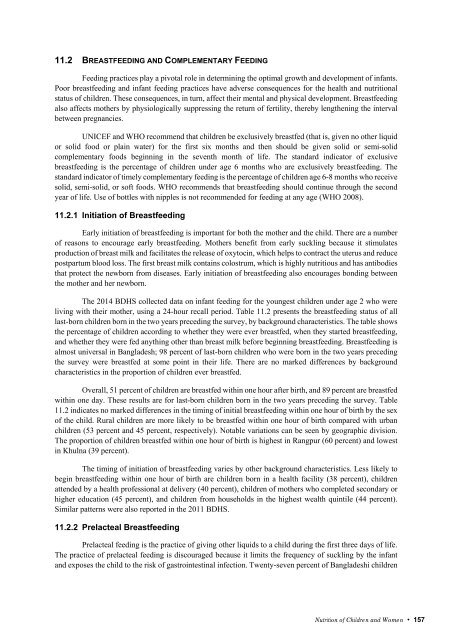Bangladesh 2014
8ln3LMTjp
8ln3LMTjp
Create successful ePaper yourself
Turn your PDF publications into a flip-book with our unique Google optimized e-Paper software.
11.2 BREASTFEEDING AND COMPLEMENTARY FEEDING<br />
Feeding practices play a pivotal role in determining the optimal growth and development of infants.<br />
Poor breastfeeding and infant feeding practices have adverse consequences for the health and nutritional<br />
status of children. These consequences, in turn, affect their mental and physical development. Breastfeeding<br />
also affects mothers by physiologically suppressing the return of fertility, thereby lengthening the interval<br />
between pregnancies.<br />
UNICEF and WHO recommend that children be exclusively breastfed (that is, given no other liquid<br />
or solid food or plain water) for the first six months and then should be given solid or semi-solid<br />
complementary foods beginning in the seventh month of life. The standard indicator of exclusive<br />
breastfeeding is the percentage of children under age 6 months who are exclusively breastfeeding. The<br />
standard indicator of timely complementary feeding is the percentage of children age 6-8 months who receive<br />
solid, semi-solid, or soft foods. WHO recommends that breastfeeding should continue through the second<br />
year of life. Use of bottles with nipples is not recommended for feeding at any age (WHO 2008).<br />
11.2.1 Initiation of Breastfeeding<br />
Early initiation of breastfeeding is important for both the mother and the child. There are a number<br />
of reasons to encourage early breastfeeding. Mothers benefit from early suckling because it stimulates<br />
production of breast milk and facilitates the release of oxytocin, which helps to contract the uterus and reduce<br />
postpartum blood loss. The first breast milk contains colostrum, which is highly nutritious and has antibodies<br />
that protect the newborn from diseases. Early initiation of breastfeeding also encourages bonding between<br />
the mother and her newborn.<br />
The <strong>2014</strong> BDHS collected data on infant feeding for the youngest children under age 2 who were<br />
living with their mother, using a 24-hour recall period. Table 11.2 presents the breastfeeding status of all<br />
last-born children born in the two years preceding the survey, by background characteristics. The table shows<br />
the percentage of children according to whether they were ever breastfed, when they started breastfeeding,<br />
and whether they were fed anything other than breast milk before beginning breastfeeding. Breastfeeding is<br />
almost universal in <strong>Bangladesh</strong>; 98 percent of last-born children who were born in the two years preceding<br />
the survey were breastfed at some point in their life. There are no marked differences by background<br />
characteristics in the proportion of children ever breastfed.<br />
Overall, 51 percent of children are breastfed within one hour after birth, and 89 percent are breastfed<br />
within one day. These results are for last-born children born in the two years preceding the survey. Table<br />
11.2 indicates no marked differences in the timing of initial breastfeeding within one hour of birth by the sex<br />
of the child. Rural children are more likely to be breastfed within one hour of birth compared with urban<br />
children (53 percent and 45 percent, respectively). Notable variations can be seen by geographic division.<br />
The proportion of children breastfed within one hour of birth is highest in Rangpur (60 percent) and lowest<br />
in Khulna (39 percent).<br />
The timing of initiation of breastfeeding varies by other background characteristics. Less likely to<br />
begin breastfeeding within one hour of birth are children born in a health facility (38 percent), children<br />
attended by a health professional at delivery (40 percent), children of mothers who completed secondary or<br />
higher education (45 percent), and children from households in the highest wealth quintile (44 percent).<br />
Similar patterns were also reported in the 2011 BDHS.<br />
11.2.2 Prelacteal Breastfeeding<br />
Prelacteal feeding is the practice of giving other liquids to a child during the first three days of life.<br />
The practice of prelacteal feeding is discouraged because it limits the frequency of suckling by the infant<br />
and exposes the child to the risk of gastrointestinal infection. Twenty-seven percent of <strong>Bangladesh</strong>i children<br />
Nutrition of Children and Women • 157


